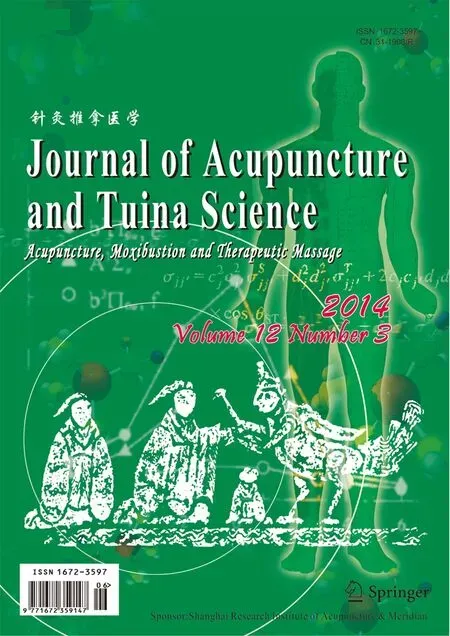Therapeutic Effect Observation on Combining Electroacupuncture and Tuina for Migraine
2014-06-19
Community Health Service Center, Huajing Township, Xuhui District, Shanghai, Shanghai 200231, China
TUINA TECHNIQUE AND EXERCISE
Therapeutic Effect Observation on Combining Electroacupuncture and Tuina for Migraine
Guo Qing, Hua Yu, Wang Hai-qin, Li Ying, Ji Quan
Community Health Service Center, Huajing Township, Xuhui District, Shanghai, Shanghai 200231, China
Author: Quo Qing, attending physician.
E-mail: xxbgqgq@163.com
Objective: To observe the clinical effect of combining electroacupuncture and local tuina for migraine.
Methods: A total of 94 migraine cases were randomly allocated into an observation group and a medication group, 48 cases in each group. Electroacupuncture and local tuina were used for cases in the observation group, whereas oral Flunarizine Hydrochloride capsules were used for cases in the medication group. Then the frequency of attacks, severity of the pain, duration of the headache, and associated symptoms of headache before and after treatment in the two groups were observed and compared.
Results: The total effective rate in the observation group was 93.8%, versus 63.0% in the medication group, showing a statistical significant difference (P<0.05). There were statistical significant differences in frequency of attacks, severity of the pain, duration of the headache and associated symptoms between the two groups (P<0.05). In addition, there were statistical significant differences in relapse rates after 4 and 8 weeks of treatment (P<0.05).
Conclusion: Combining electroacupuncture and local tuina can obtain better effect and lower relapse rate than oral Flunarizine Hydrochloride capsules in migraine patients.
Acupuncture Therapy; Electroacupuncture; Tuina; Massage; Migraine Disorders; Headache
Migraine is a common but difficult neurological disorder characterized by recurrent headaches. It may affect one or both sides of the head, pulsating in nature. Associated symptoms may include nausea, vomiting, and sensitivity to light or sound. Due to its frequent attacks, severe pain and periodic recurrence, migraine can greatly affect the patients’ quality of life and work. It has been reported that patients have a low quality of life even during intermission. Since the underlying causes of migraines are unknown, there is no cure yet. We’ve treated 48 cases with electroacupuncture plus local tuina and compared with medication. The report is now summarized as follows.
1 Clinical Materials
1.1 Diagnostic criteria
The diagnosis of migraine without aura can be made according to following criteria seen in the 2nd edition ofInternational Classification of Headache Disorders(ICD-II) by the International Headache Society[1]. Atleast five attacks fulfilling the following three criteria. Headache attacks lasting 4-72 h; unilateral location, pulsating quality, moderate or severe pain intensity and aggravation by or causing avoidance of routine physical activity (e.g., walking or climbing stairs);during headache at least one of the following: nausea and/or vomiting, photophobia and phonophobia; and not attributed to another disorder, at least conforming to one of the following: history and physical and neurological examinations do not suggest any of organic disorders, or history and/or physical and/or neurological examinations do suggest such disorder but it is ruled out by appropriate investigations, or such disorder is present but attacks do not occur for the first time in close temporal relation to the disorder.
1.2 Inclusion criteria
Men and women at any age who met the above diagnostic criteria and were willing to participate in this trial and sign the informed consent.
1.3 Exclusion criteria
Those with headaches due to systemic infection, hypertension, hypotension, ENT problems and cranial disorder, and those with complications of severe heart, brain and kidney diseases.
1.4 Termination and rejection criteria
Those who failed to adhere to treatment; those who failed to follow the treatment protocol; and those with severe complications or aggravation during treatment.
1.5 Statistical method
After Epidata entry, use SPSS 13.0 version software for statistical analysis,t-test for measurement data (expressed withand Chi-square test for numeration data.Pvalues less than 0.05 indicate a statistical significance.
1.6 General data
A total of 94 migraine cases were treated in Acupuncture and Tuina Outpatient Department in our hospital between August 2011 and August 2013. There were no statistical differences in gender, age, duration and pain severity between the two groups (allP>0.05), indicating that the two groups were comparable (Table 1).

Table 1. Between-group comparison of general data
2 Treatment Methods
2.1 Observation group
2.1.1 Electroacupuncture
Treatment principle: To soothe the liver and gallbladder, unblock meridians to stop pain.
Points: Ashi points, Taiyang (EX-HN 5), Touwei (ST 8), Benshen (GB 13), Xuanlu (GB 5) and Zulinqi (GB 41) on the affected side; bilateral Fengchi (GB 20), Baihui (GV 20) and Shenting (GV 24).
Adjunct points: Taichong (LR 3), Taixi (KI 3) and Xiaxi (GB 43) for headache due to hyperactivity of liver yang; Zhongwan (CV 12), Fenglong (ST 40) and Yinlingquan (SP 9) for headache due to phlegmturbidity; Neiguan (PC 6), Xuehai (SP 10) and Geshu (BL 17)[2]for headache due to stagnant blood.
Method: The patient took a sitting position. Upon routine sterilization, disposable filiform needles of 0.30 mm in diameter and 25-50 mm in length were used for above points. After arrival of qi, 1-minute reducing manipulation by twirling or rotating was performed. Then the SDZ-II electric stimulator was connected, using sparse-dense wave and frequency of 2 Hz/100 Hz. The needles were retained for 20 min. The treatment was done once every day, 10 d constituted a course of treatment. The patients were treated for two courses of treatment. There was a 3-day interval between two courses.
2.1.2 Tuina therapy
Treatment principle: To dredge meridians and remove pathogenic factors to stop pain.
Manipulations: One-thumb Tui-pushing, Nagrasping, An-pressing, Rou-kneading, Saosansweeping, Fen-parting and Ca-rubbing manipulations.
Points and areas: Yintang (GV 29), Taiyang (EX-HN 5), Baihui (GV 20), Fengchi (GB 20), Touwei (ST 8), Jiaosun (TE 20), Cuanzhu (BL 2), head, forehead, and bilateral sides of the head (Gallbladder Meridian).
Method: The patient took a sitting position. The practitioner first applied 4-5 times of One-thumb Tui-pushing from Yintang (GV 29) to the anterior hairline, then from Yintang (GV 29) to Jingming (BL 1) on one side along the superciliary arc and then alternately to Jingming (BL 1) on the other side, 3-4 times on each side. Next, applied rubbing to the forehead from Taiyang (EX-HN 5) on one side to Taiyang (EX-HN 5) on the other side, 3-4 times oneach side (Figure 1). After this, applied Saosansweeping to both sides of the head (Gallbladder Meridian) from top to bottom, 20-30 times on each side (Figure 2). Then, Fen-parted from Yintang (GV 29) to Taiyang (EX-HN 5) on both sides along the superciliary arc, 4-5 times on each side (Figure 3), coupled with An-pressing Yintang (GV 29), Jingming (BL 1), Taiyang (EX-HN 5), and Jiaosun (TE 20) for approximately 3 min. Finally, applied Na-grasping to the vertex from anterior hairline to the nape using five fingers first and then three fingers (Figure 4) from both sides of the nape to Dazhui (GV 14) for 4-5 times, coupled with An-pressing Baihui (GV 20) and Na-grasping Fengchi (GB 20), (Figure 5).
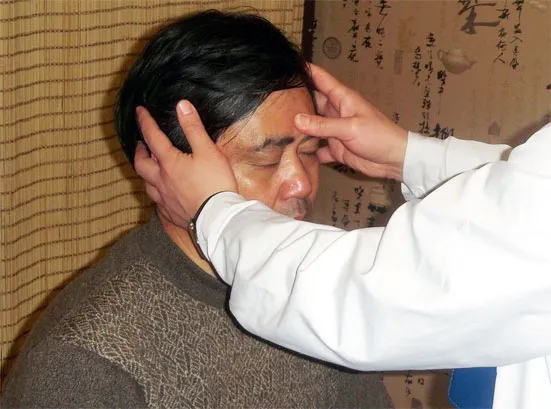
Figure 1. One-thumb Tui-pushing manipulation
Modifications: For headache due to hyperactivity of liver yang, combine with Tui-pushing Qiaogong from top to bottom, 20 times on each side, An-pressing and Rou-kneading bilateral Taichong (LR 3) and Xingjian (LR 2) to produce a sore or distending sensation and Ca-rubbing bilateral Yongquan (KI 1) to produce a warm sensation; for headache due to phlegmturbidity, combine with one-thumb Tui-pushing and round Mo-rubbing the abdomen for approximately 3 min, particularly Zhongwan (CV 12) and Tianshu (ST 25) and An-pressing and Rou-kneading Pishu (BL 20), Weishu (BL 21), Zusanli (ST 36) and Fenglong (ST 40) for approximately 3 min; for headache due to stagnant blood, combine with one-thumb Tui-pushing the painful area, Ca-rubbing the forehead and Taiyang (EX-HN 5) on both sides (using some wintergreen oil for lubrication) until a warm sensation occurs, and An-pressing and Rou-kneading Geshu (BL 17), Xuehai (SP 10) and Sanyinjiao (SP 6) for approximately 5 min.
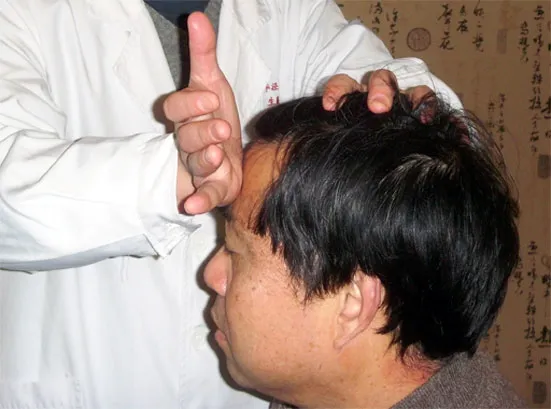
Figure 2. Ca-rubbing manipulation
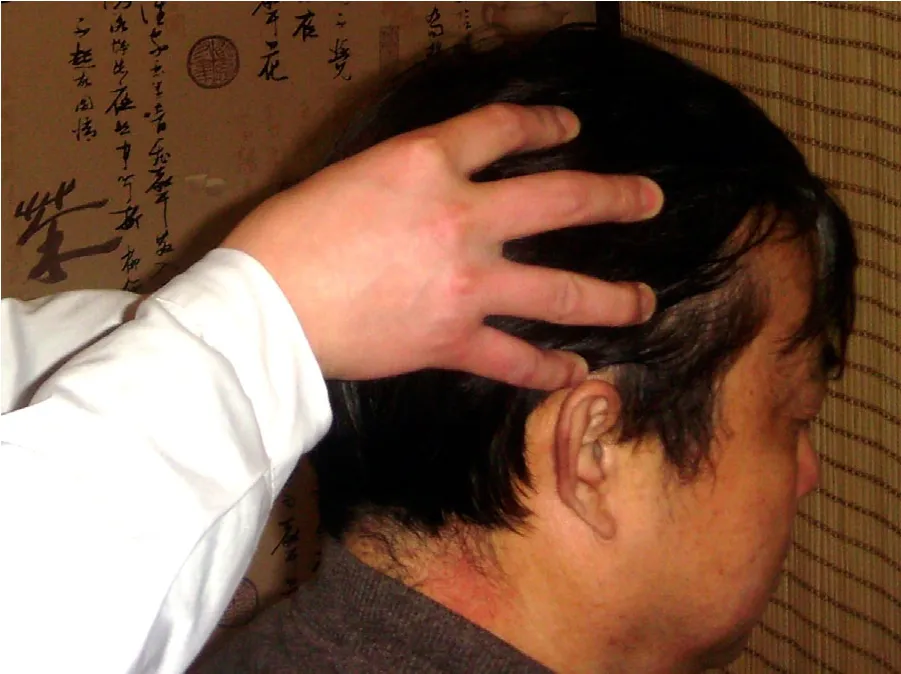
Figure 3. Saosan-sweeping manipulation

Figure 4. Na-grasping manipulation
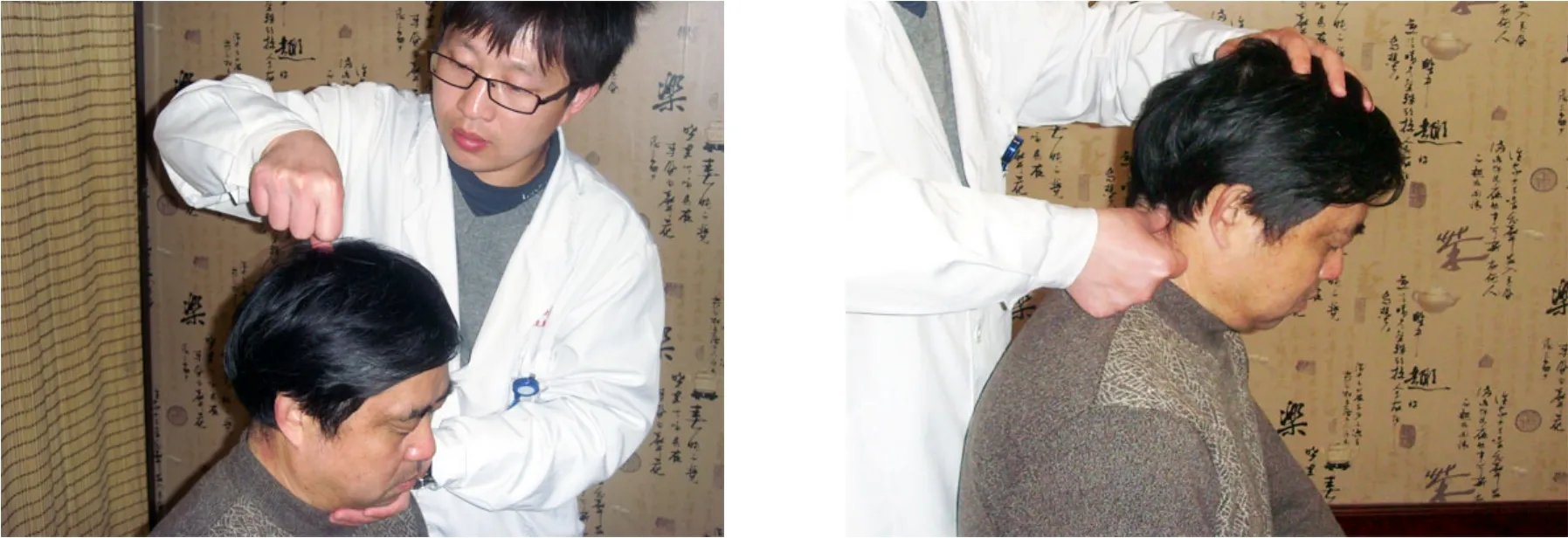
Figure 5. Digital An-pressing manipulation
Tuina treatment was done every day for 10 d successively (1 course of treatment). The patients were treated for two courses of treatment. There was a 3-day interval between two courses.
2.2 Medication group
As for cases in the control group, 5 mg of oral Flunarizine Hydrochloride capsules for each dose, 2 doses a day, and 10 d for 1 course of treatment. The patients were treated for 2 courses of treatment.
3 Therapeutic Efficacy Observation
3.1 Observation indexes
The observation indexes included frequency of attacks, severity of the pain, duration of headache and improvement of associated symptoms before and after treatment. Recorded and scored all above information and got a total score. Then statistical personnel calculated the specific scores after the document had been signed by the patients.
3.2 Criteria for clinical efficacy
The frequency of attacks, severity of the pain, duration of headache and associated symptoms were scored according to standard scoring method by Sun ZH, et al[3].
Frequency of attacks (monthly) was summarized and scored as follows.
6 points: >5 times.
4 points: 3-4 times.
2 points: <2 times.
Severity of the pain was scored.
6 points: Bed rest (inability to move).
4 points: Pain affecting physical activities.
2 points: Pain not affecting the physical activities.
Duration of headache was scored.
6 points: >2 d.
4 points: 12 h-2 d.
2 points: <12 h.
Associated symptoms were scored as following criteria.
6 points: At least three symptoms of nausea, vomiting, photophobia and phonophobia.
2 points: Two symptoms. 1 point: One symptom.
The therapeutic index (TI) was calculated by the total scores before and after treatment according to the following formula:
TI = (Total pre-treatment score — Total posttreatment score) ÷ Total pre-treatment score × 100%.
The criteria for clinical efficacy were made according to TI.
Recovery: No migraine attacks during treatment. Marked effect: TI >50%.
Improvement: TI ≥20% but ≤50%.
Failure: TI <20%.
3.3 Treatment results
3.3.1 Between-group comparison on treatment effect
The total effective rate in the observation group was 93.8%, versus 63.0% in the medication group, showing a statistical difference (P<0.05) and a better effect in the observation group (Table 2).
3.3.2 Comparisons on item scores before and after treatment
Before treatment, there were no statistical differences in scores of frequency of attacks, severity of the pain, duration of headache and associated symptoms between the two groups (P>0.05). After treatment, the scores of first three items in both groups were significantly decreased (P<0.05), but more significant in the observation group (P<0.05). This indicates that combining electroacupuncture and local tuina obtained better effect than oral Flunarizine Hydrochloride capsules in reducing frequency of attacks, alleviating pain, shortening duration of headache, and alleviating associated symptoms (Table 3).

Table 2. Comparison on clinical effect (case)
Table 3. Comparisons on item scores before and after treatment (point)

Table 3. Comparisons on item scores before and after treatment (point)
Note: Intra-group comparison before and after treatment, 1) P<0.05; inter-group comparison after treatment, 2) P<0.05
?
3.3.3 Between-group comparison on relapse rates
The follow-up has shown 11.1% and 24.4% relapse rates in the observation group 4 and 8 weeks after treatment, versus 37.9% and 62.1% in the medication group, indicating statistical differences between the two groups (P<0.05) and lower relapse rate in the observation group (Table 4).

Table 4. Between-group comparison on relapse cases (case)
4 Discussion
In Chinese medicine, migraine is known as‘headache’, ‘head wind’ or ‘brain wind’. It can be caused by external pathogenic factors or internal injury. External pathogenic factors include wind, cold, dampness and heat. Internal injury is often associated with dysfunctions of the liver, spleen and kidney. According to Chinese medical theory, the root cause of migraine is deficiency of the liver, spleen and kidney and its clinical manifestations are often related to wind, fire and phlegm and stasis.
Of points selected in this study, Ashi points and Taiyang (EX-HN 5) activate meridian qi, relieve pain and tranquilize the mind and are often used as experienced points for headache; Baihui (GV 20) balances yin and yang and calms the mind; Touwei (ST 8) is a crossing point of the Gallbladder and Stomach Meridians and can therefore dredge qi of the two meridians; Benshen (GB 13) is a crossing point of the Gallbladder Meridian and the Yang Link Vessel and can remove wind, relieve convulsions, calm the mind and alleviate pain; Xuanlu (GB 5) is a crossing point of the Triple Energizer, Gallbladder and Large Intestine Meridians and can down-regulate turbidity and resolve dampness; Fengchi (GB 20) clears heat, removes wind, circulates blood and relieves pain; distal point Zulinqi (GB 41) is the Shu-Stream point and one of the Eight Confluent Points with the Belt Vessel and can remove wind and resolve water-dampness. Combination of the above points can circulate blood, soothe liver wind, resolve phlegm, dispel wind and alleviate pain[4]. Furthermore, sparse-dense wave of electroacupuncture[5-6]can help to circulate qi and blood and increase metabolism[7-8]. Since all three yang meridians of hands and feet gather at the head and face, the Liver Meridian and the Governor Vessel cross at the vertex and yin-essence and yang-qi of Zang-fu organs ascend to the head, local (head and face) tuina[9-12]can balance yin and yang, regulate qi activities of Zang-fu organs, dredge meridians, dissipate cold, relieve pain and calm the mind. Combing the Gallbladder Meridian can further strengthen the above effect. What’s more, patients are willing to accept comfortable local tuina. Combined with electroacupunctur, they can work together to unblock meridians and stop pain.
Conflict of Interest
The authors declared that there was no conflict of interest in this article.
Acknowledgments
This work was supported by Community Health Service Center, Huajing Township, Xuhui District, Shanghai.
Statement of Informed Consent
Informed consent was obtained from all individual participants included in this study.
[1] Headache Classification Committee of the International Headache Society. Classification and diagnostic criteria for headache disorders, cranial neuralgias, and facial pain. Cephalagia, 1998, 8(Supp17): 1-96.
[2] Yang DH, Zhu PY, Han J, Zhang YC, Zhao SL, Jia HL, Shan QH. Observations on the efficacy of liver-soothing and mind-regulating acupuncture in treating anxiety and depression in tension headache patient. Shanghai Zhenjiu Zazhi, 2011, 30(2): 87-89.
[3] Sun ZH, Yang YJ. Therapeutic evaluation and diagnosis of migraine. Zhongfeng Yu Shenjing Jibing Zazhi, 1995, 12(1): 110-111.
[4] Dai M, Jin M, Shen WN. Observations on the curative effect of acupuncture on migraine and its influence on cerebral blood flow. Shanghai Zhenjiu Zazhi, 2007, 26(9): 3-5.
[5] Yan SM, Guo FZ, Liu FP, Wang RP. Analgesic effect of sparse-dense wave electroacupuncture on cervicogenic shoulder pain in 79 cases. Fujian Zhongyiyao, 2010, 42(5): 42.
[6] Chen X, Yao ZF, Ye XR, Han J, Lin Y, Ge SY, Huang XQ. Comparison of dynamic sensations characteristics during Quanliao (SI 18) stimulated by pulse of sparse-dense wave electroacupuncture and continuous wave electroacupuncture. Fujian Zhongyiyao Daxue Xuebao, 2011, 21(1): 6-8.
[7] Yuan J, Fang JY, Li M, Wang YM. Clinical observation on migraine due to hemorheological abnormality in the treatment of acupuncture therapy according to TCM differentiation of syndromes. Hebei J TCM, 2004, 26(5): 361-363.
[8] Fang Z, Zhang BM. Observation on clinical effects of electroacupuncture for migraine without aura. J Acupunct Tuina Sci, 2014, 12(1): 21-25.
[9] Luo JX, Lu YJ, Huang Y, Lin RY, Xiao HL, Zhang XY. Acupuncture point selection rules in the treatment of migraine. Xiandai Zhongxiyi Jiehe Zazhi, 2012, 21(6): 1711-1715.
[10] Huang HY, Su QL. The clinical observation of treating splitting headache by massaging face and head and acupuncturing distant acupoint. World Health Digest, 2010, 7(33): 419-420.
[11] Yan BX, Fu YM. Acupuncture and tuina for migraine in 86 cases. Shaanxi Zhongyi, 2001, 22(12): 755.
[12] He YF, Wang X. Combined tuina and acupuncture for 142 cases of cervical headache. J Acupunct Tuina Sci, 2011, 9(2): 116-119.
Translator:Han Chou-ping
R246.6
: A
Date:January 27, 2014
杂志排行
Journal of Acupuncture and Tuina Science的其它文章
- Study on Burning Temperature Versus Time Graph of Moxa Sticks in a Novel Animal Moxibustion Device
- Therapeutic Efficacy of Tuina in Treating 48 Cases with Knee Osteoarthritis
- Observation on Clinical Effects of Tuina plus Hot Compress for Infantile Diarrhea Due to Spleen-kidney Yang Deficiency
- Therapeutic Efficacy Observation on Combined Taijiquan and Auricular Point Sticking for Perimenopausal Insomnia
- Clinical Study on Point Application Using Chinese Herbal Medicine for Pediatric Chronic Cough
- Clinical Study on Fu’s Subcutaneous Needling with Laser for Postherpetic Neuralgia
